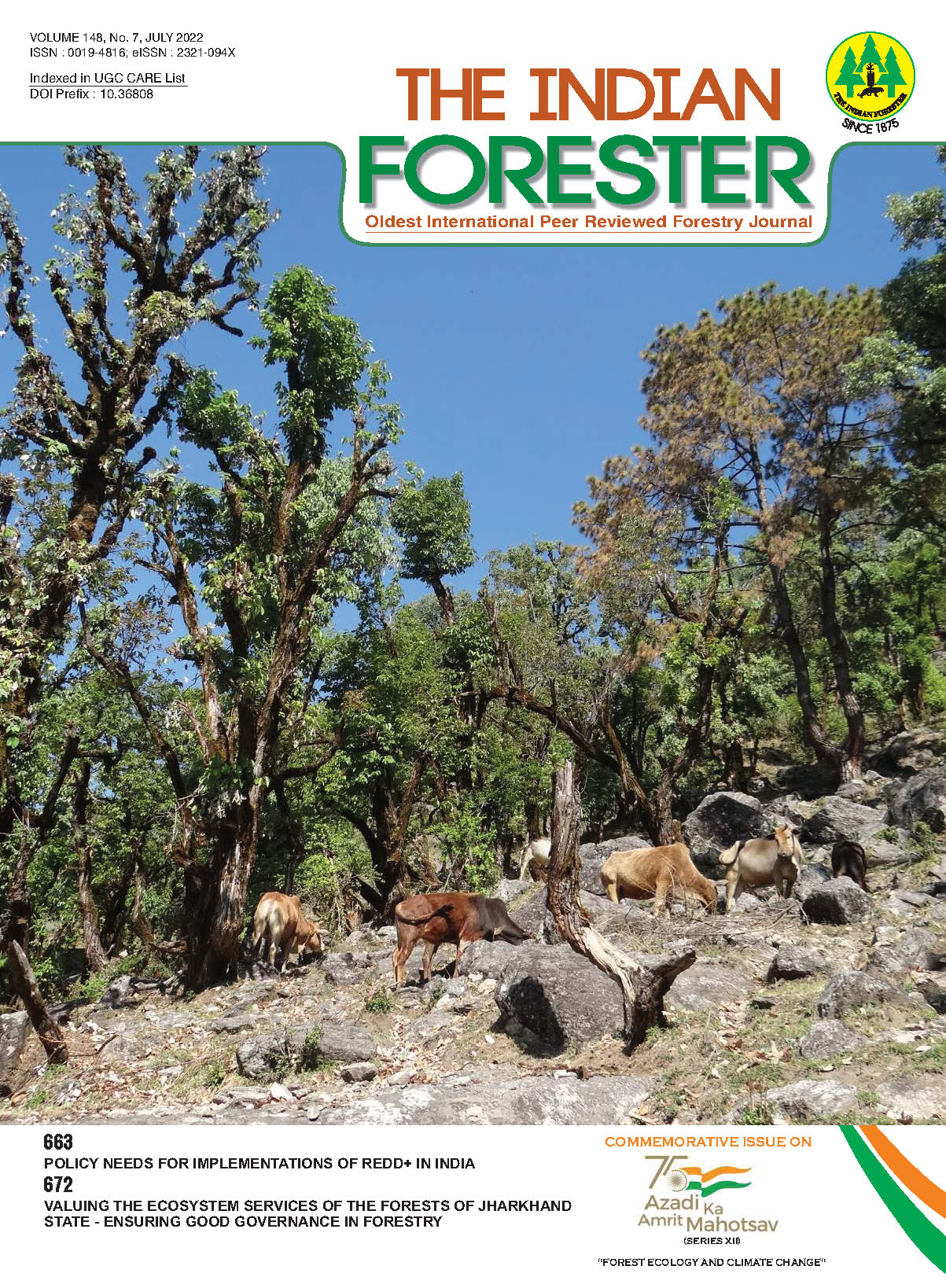Litter Nutrient Dynamics in Quercus semecarpifolia Sm. Forests of Western Himalaya
DOI:
https://doi.org/10.36808/if/2022/v148i7/165714Keywords:
Litterfall, litter nutrient, nutrient pattern, nutrient returnAbstract
Litterfall plays an important role in carbon and nutrient cycling of a forest ecosystem influenced by climate, vegetation, forest type and age. The study evaluate the litter production and estimate the amount of nutrient returned through it to the forest floor of Quercus semecarpifolia. The species commonly occur at an altitude of 2400-3600 m AMSL in the western Himalayas. Maximum annual litter production was recorded 8474.15 kg ha-1yr-1. On average, 7386.35 kg ha-1 yr-1of leaf litter was recorded, which contributed about 87 percent to the total litter production. Minimum contribution (36.65 kg ha-1 yr-1) was through bark litter. Analysis of monthly data showed maximum litterfall during May (2510.50 kg ha-1) and minimum during October (384.15 kg ha-1). Nutrient content in the litter showed a reverse trend that higher nitrogen content was recorded during August (1.548) and minimum during May (1.074). Maximum contribution to nitrogen concentration was observed through leaf litter and minimum through the reproductive litter. Phosphorous concentration was also recorded with a maximum from August to October and a minimum during May and July. Overall, the nutrient return showed the annual pattern in the order of Ca > N > K > Mg > P.Â
References
Bellingham P.J., Morse C.W., Buxton R.P., Bonner K.I., Mason N.W.H. and Wardle D.A. (2013). Litterfall, nutrient concentrations and decomposability of litter in a New Zealand temperate montane rain forest, N. Z. Journal of Ecology, 37: 162-171.
Brady C.J. (1973). Chemistry and Biochemistry of Herb-age (eds., Butler and Baily), Academic Press London, 2, pp. 317-351.
Brant A.N. and Chen H.Y. (2015). Patterns and mechanisms of nutrient resorption in plants, Critical Reviews in Plant Sciences, 34(5): 471-486.
Bray J.R. and Gorham E. (1964). Litter production in forests of the World, In Advances in Ecological Research, 2, 101-157 pp.
Brinson M.M., Bradshaw H.D., Holmes R.N. and Elkins Jr J.B. (1980). Litterfall, stem flow and through fall nutrient fluxes in an Alluvial Swamp forest, Ecology, 61(4): 827-835.
Canellas I. and San A.M. (1998). Litter fall and nutrient turnover in Kermes oak (Quercus coccifera L.) shrub lands in Valencia (eastern Spain), Annales des Sciences Forestieres, 55(5): 589-597.
Chang C.T. and Hsu C.C. (1987). Seasonal variation of litterfall and nutrient contents of Japanese red cedar Chinese fir stands, Quat. Journal of Chinese Forestry, 20(4): 47-64.
Chave J., Navarrete D., Almeida S., Alvarez E., Aragao, L.E.O.C., Bonal D., Chatelet P., Silva Espejo J.E., Goret J.Y., Von Hildebrand P., Jimenez E., Patino S., Penuela M.C., Phillips O.L., Stevenson P. and Malhi Y. (2010). Regional and seasonal patterns of litterfall in tropical South America, Biogeosciences, 7: 43–55.
Christensen O. (1978). The dynamics of wood litterfall in Danish oak forest, Natura Jutlandica, 20: 155-162.
Dimri S., Baluni P. and Sharma C.M. (2018). Carbon dynamics in Quercus semecarpifolia (Kharsu Oak) and Quercus floribunda (Moru Oak) Forests of Garhwal Himalaya, India. Proc. Natl. Acad. Sci., India, Sect. B Biol. Sci., 88(1): 1157–1168. https://doi.org/10.1007/s40011-017-0852-1.
Fu C., Yang W., Tan B., Xu Z., Zhang Y., Yang J., Ni X. and Wu F. (2017). Seasonal dynamics of litterfall in a Sub-Alpine spruce-fir forest on the Eastern Tibetan Plateau: Allometric scaling relationships based on one year of observations, Forests, 8: 314.
Downloads
Downloads
Published
How to Cite
Issue
Section
License
Unless otherwise stated, copyright or similar rights in all materials presented on the site, including graphical images, are owned by Indian Forester.





